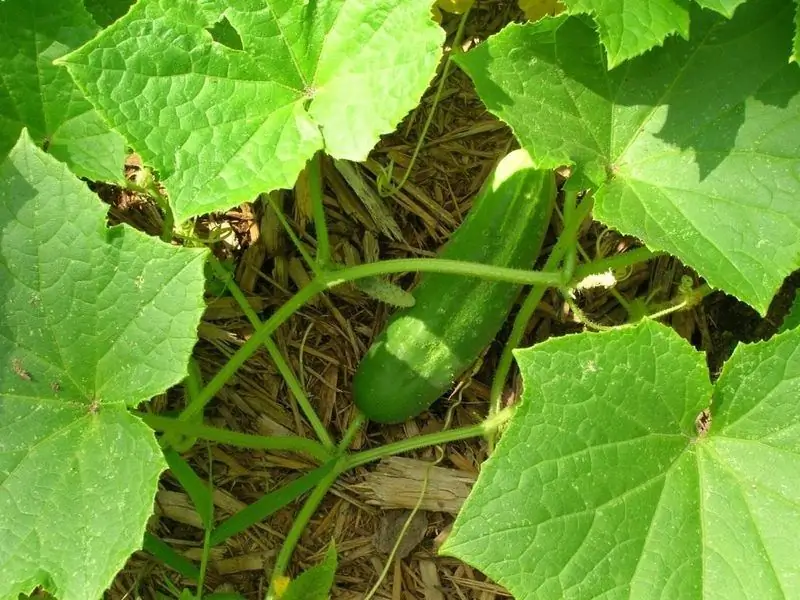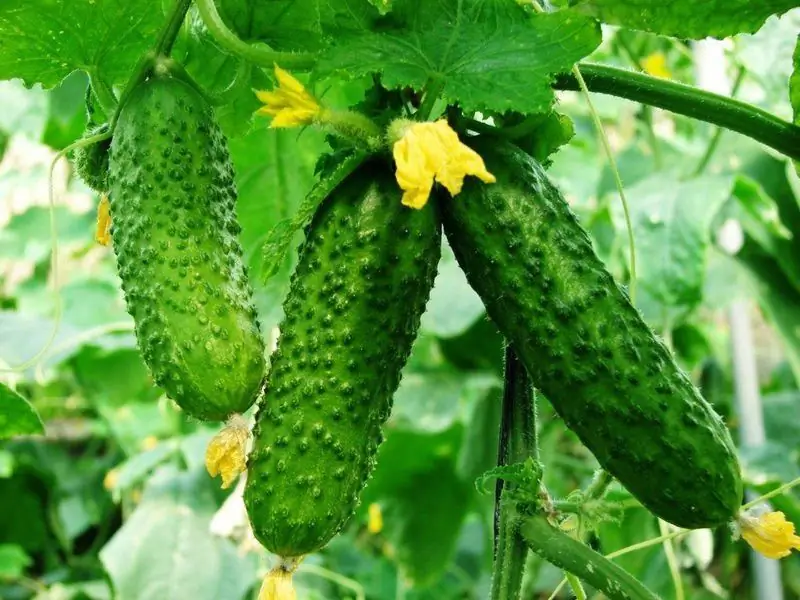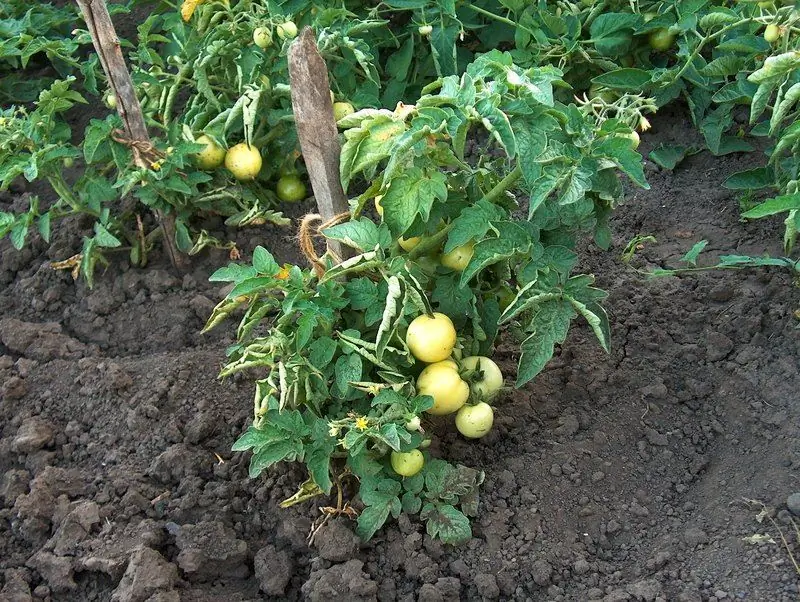
Table of contents:
- Author Bailey Albertson [email protected].
- Public 2023-12-17 12:53.
- Last modified 2025-01-23 12:41.
When and how to feed cucumbers so that the leaves do not turn yellow

Any plant reacts to timely feeding with a rich harvest. Cucumbers are no exception. Why, how, when and how to feed cucumbers? Answering these questions and putting them into practice will delight you with a good harvest of cucumbers.
Content
-
1 Why cucumbers need to be fertilized
1.1 Video: root and foliar feeding of cucumbers
-
2 How to feed cucumbers according to all the rules
- 2.1 If the leaves of a cucumber turn yellow
-
2.2 First top dressing outdoors or in a polycarbonate greenhouse
2.2.1 Video: good organic fertilizer from chicken manure
- 2.3 How to feed cucumbers during flowering and fruiting
- 2.4 Organic fertilizers for better growth of cucumbers
- 2.5 Why you shouldn't feed cucumbers in late summer and autumn
-
2.6 How to feed cucumbers with yeast
2.6.1 Video: recipe for yeast feeding
Why cucumbers need to be fertilized
To get the expected volume of cucumber harvest, they need to be fed in a timely manner, especially if they grow on poor soil. Cucumber is a culture characterized by an increased growth rate, as well as fruit ripening. What can not be said about its root system - it is quite weak. The cost for mistakes in the process of growing cucumbers is quite large, and it consists in the loss of not only the quantity, but also the quality of the fruit. To achieve consistently abundant fruiting, it is necessary to provide the cucumber with three main minerals: potassium, nitrogen and phosphorus.

Cucumber needs three minerals for full development: potassium, nitrogen and phosphorus.
Video: root and foliar feeding of cucumbers
How to feed cucumbers according to all the rules
During the summer season, with normal soil, a cucumber requires no more than 4 dressings, which are mineral and organic, and according to the method of application - root and foliar. Which method to choose, each gardener decides for himself, however, there is a single formula for their alternation, which is recommended for everyone to follow. Root feeding is especially important during the hot summer, when the root system of the plant is well developed and needs additional microelements. They must be brought into moist soil (after heavy rain or heavy watering).
Foliar dressing should be used if the summer is cool and cloudy. Under such conditions, it is difficult for the roots to cope with the assimilation of nutrition, so treating the leaves with fertilizer from a spray bottle is an excellent solution. Foliar dressing is carried out in small doses on a cloudy day or evening. The most important thing is to spray the solution in tiny drops over the entire surface of the leaves. The longer the fertilizer remains on the leaves, the more the plant absorbs nutrients.

Foliar dressing is needed if the summer is cool and cloudy.
If the leaves of a cucumber turn yellow
If the leaves of the cucumber begin to turn yellow, you need to understand the problem before going to the store for a life-saving medicine. Each case needs an individual approach.

First of all, you need to establish the cause of the yellowing of the leaves.
Yellow leaves are the first sign that the plant is missing something. Several reasons for the appearance of yellow leaves on cucumbers:
- If the lowest leaves turn yellow, this indicates a lack of light. Perhaps the plants are too densely planted to thin out enough.
- If the leaves not only turn yellow, but also curl, then the reason lies in uneven watering. For example, excess or lack of moisture. In hot summers without rains, cucumbers need to be watered every day. If you take a handful of earth from a depth of 10 cm, you can easily determine whether your cucumbers receive enough moisture: a lump does not form after squeezing in the palm of your hand - there is not enough moisture; holds tight and does not fall apart - cucumbers are too flooded.
- If yellow spots appear pointwise and spread throughout the plant, it means that it is infected with a fungal disease. In this case, foliar feeding from the following solution helps perfectly: for 1 liter of milk, take 20 grams of laundry soap and 30 drops of iodine. It is necessary to spray every day in the evening until 3 healthy leaves appear, and then every 10 days. Or apply a fungicide that suppresses the fungal flora on the plant.
- Another reason for yellowed leaves is pests. A spider mite or whitefly sucks out all the juices from the leaves. The leaves gradually turn yellow and die off, therefore, the plant receives insufficient nutrition. Coping with whitefly or spider mites is difficult: it may take a week or more. For spraying, you must use insecticides. The garden store usually has a wide range of insecticides available. It is better to buy several at once, since both the spider mite and the whitefly quickly get used to the same drug, so they must be alternated every 2 days.
First top dressing outdoors or in a polycarbonate greenhouse
Cucumbers that grow in a polycarbonate greenhouse are well protected from the wind. They get enough sunlight, but watering time must not be missed, otherwise drought will lead to plant disease, depletion and loss of crops.
Cucumbers in the garden are good in sunny weather, but very bad in heavy rains and strong winds. Plants begin to ache and disappear. To prevent this from happening, you need to mulch the ground with straw or stale sawdust. Heavy rains wash out nutrients from the soil that cucumbers did not have time to digest. But you can't overdo it with top dressing. The feeding schemes are the same for both ground and greenhouse cucumbers. However, if you overfeed the ground cucumber, complaining about the heavy rains that washed out trace elements from the soil, the plant will simply "burn out". At a temperature of +12 ° C and below, foliar dressing by spraying the leaves will be most effective. In the greenhouse, the first feeding is carried out when the second or third true leaf appears on the lash. In 10 liters of water (not lower than 20 ° C), dilute:
- 20 grams of potassium sulfide or 15 grams of potassium chloride;
- 25 grams of double superphosphate;
- 15 grams of ammonium nitrate.
The resulting fertilizer is enough to water 10-15 plants.

The first feeding is carried out at the stage of two true sheets
A second feeding is carried out at least two weeks later. At this stage, mass flowering appears on the plants, the first ovaries are visible. During this period, organic feeding from poultry manure, mullein or horse manure becomes optimal. Dissolve 0.5 liters of organic matter in a bucket of water, add 1 tablespoon of Nitrofoska. Mix well. The finished fertilizer can be used in this form, but, as practice has shown, the following additives to it significantly improve the result:
- 0.5 grams of boric acid;
- 50 grams of potassium sulfide or 1 cup of wood ash;
- 0.3 grams of manganese sulfate.
Watering plants is carried out at the rate of 3 liters of ready-made solution per 1 m 2.

The second feeding is carried out during the period of mass flowering and the formation of the first ovaries
The third feeding is carried out 20-25 days after the second, and now it is better to make a choice in favor of only organic fertilizers (herbal infusion or chicken / cow dung), since the fruits are actively growing on the whips. If there are no signs of pests or fungal diseases, the fourth feeding is also carried out every 3 weeks with organic fertilizers.

For the third feeding, it is better to choose organic fertilizer.
For cucumbers planted in open ground, the same types of fertilizers are used as for greenhouse cucumbers. After two weeks after planting, give the first feeding. At this time, any complex nitrogen-containing mineral fertilizers will do.
The second feeding is carried out with the appearance of the first flowers on the plant. At this stage of growth, it is advisable to feed the cucumbers with phosphorus, potash and nitrogen fertilizers with sulfur. Plants must be watered with Nitrofoski solution (one tablespoon is diluted in 10 liters of water).
Organic fertilizers: mullein, bird droppings, manure diluted in water, herbal infusion - all this will have a good effect on the growth of cucumbers in any growing season. A week after the second feeding, 0.5 liters of mullein is bred in a bucket of water, adding one teaspoon of potassium sulfate.

Root dressing is applied through watering
The third feeding is carried out when many fruits are tied on the plant. This is done with the aim of extending the growth period of cucumber lashes and stimulating the appearance of new ovaries on them. Here it is enough to feed the cucumbers with organic fertilizers once a week. But if the plant has slowed down in development, then special growth stimulants should be used.
Video: good organic fertilizer from chicken manure
How to feed cucumbers during flowering and fruiting
During the flowering period, cucumbers need mandatory feeding. At this time, the plant consumes a large amount of microelements from the soil, and it needs to be helped to “withstand” abundant flowering and the beginning of fruit formation - this is what determines the volume and quality of the crop. For this, a complex of fertilizers for the second feeding is suitable. Some gardeners apply foliar dressing a week after fertilizing the ground, spraying the leaves with boric acid (1/4 tablespoon), which is diluted in 10 liters of water.
The fruiting phase is the most consumable in terms of the consumption of nutrients from the soil. To avoid disrupting the formation of a large crop and replenish the reserves of trace elements in the soil, with the appearance of the first fruit, the cucumbers must be fed in stages with a solution of Nitrofoski (for 10 liters of water 1 tablespoon), and after a week - with a solution of mullein with the addition of one tablespoon of potassium sulfate, alternating in a week it with a natural growth stimulant - herbal infusion.

The fruiting phase is the most consumable in terms of the consumption of nutrients from the soil.
Organic fertilizers for better cucumber growth
The best effect on the growth of greenhouse and ground cucumbers is the alternation of organic and mineral fertilizers. The breeding of bird droppings, horse manure and mullein was mentioned above. However, there is another type of very effective organic fertilizer and natural growth stimulant - herbal infusion (fermented herb). It is prepared very simply: 2/3 parts of any grass are poured into a barrel and poured to the top with water. The infusion should stand in the sun for several days. To speed up the fermentation process, add rye bread and a jar of old jam. Then, 10 cm furrows are made near the plants and the nutrient mixture is poured into them instead of watering. The grass remaining in the barrel must be spread out under the bushes, since it contains many nutrients for the cucumber. At this infusion, cucumbers "grow by leaps and bounds."

The grass remaining in the barrel must be spread out under the bushes.
Why you shouldn't feed cucumbers in late summer and autumn
Cucumbers are a thermophilic crop that is planted in a greenhouse or in open ground when frost threats pass - in late spring. All stages of dressing in the spring-summer period are described above. Cucumbers planted in the spring, in the fall with a decrease in daylight hours and the onset of cool nights, greatly slow down growth. In addition, the plant has exhausted almost all resources for flowering and fruiting, and at the end of August - September it forms the last fruits, but much more slowly than in warm weather.
In this case, feeding becomes ineffective. The best solution would be to collect the remaining fruits in order to prepare the greenhouse or ridge for the next harvest next year, sowing the land with siderates: Shrovetide radish, mustard, buckwheat and others. This step should not be neglected. The key to a good harvest is a timely prepared soil in the fall, and for this it must "rest" and be saturated with microelements obtained from other green manure plants.

In September, the plants are still actively blooming, but with the first frost they will immediately die
How to feed cucumbers with yeast
There is one more, rather new type of feeding for plants, including cucumbers, - feeding with yeast. This method has just begun to spread among gardeners, but it has already shown excellent results in high yields of cucumbers.

For yeast feeding, fresh (pressed) and dry yeast are used
The secret is simple: yeast is very rich in trace elements that have a positive effect on plant nutrition. A universal fertilizer recipe: Dissolve 100 grams of yeast in a bucket of water and let it brew for 1 day. With this composition, cucumbers should be watered only at the root.
Feeding cucumbers with yeast contributes to an increase in the mass of fruits and the total number of ovaries, a decrease in the number of barren flowers and a decrease in the hollowness of fruits several times. Dried rye bread is used instead of or together with yeast. It acts as a leaven, but yeast must be added to start the fermentation process.

Infusion of herbs and black bread with yeast is often used as a top dressing for cucumbers
Watering cucumbers with yeast fertilizer is carried out in two stages:
- The first time feeding with yeast is given after planting seedlings in the ground or after the appearance of the first two true leaves, if the cucumbers were planted with seeds. To begin with, it is necessary to apply nitrogen-containing fertilizers as in the obligatory first feeding described above, and after a few days - yeast feeding.
- The second time the plants are watered with yeast a few days after the second mandatory feeding with phosphorus fertilizers.
Subsequent top dressing is carried out with each scheduled watering. The water is simply replaced with a yeast solution. For greater mineralization, fertilizers use a herbal base of weeds, which are kneaded and allowed to brew on yeast for a day.
For cucumbers, the following recipe is most effective:
- 500 grams of bread crumb or 200 grams of crackers;
- 500 grams of green grass;
- 500 grams of compressed yeast.
Warm water is poured into a bucket of 10 liters, all the ingredients are added, they are thoroughly kneaded and mixed. Let it brew in a warm place for two days.
Video: recipe for yeast feeding
Cucumbers are a southern crop that requires not only a certain microclimate, but also timely feeding, contributing to the collection of a good harvest. There is no difference between greenhouse and open field top dressing. If the cucumbers receive nutrients on time, then the crop of excellent quality can be harvested until the first frost.
Recommended:
Growing Cucumbers On A Trellis In The Open Field - Rules + Photos And Videos

Features of growing cucumbers on a trellis in the open field. Construction and installation of trellises, preparation for planting cucumbers, rules for planting in open ground
How To Plant And Grow Cucumbers In The Open Field: Plant Seeds, Properly Care For Plants (water, Form, Tie Up)

What varieties and hybrids of cucumbers can be grown in the open field. Features of planting seeds and seedlings. Choice of place and timing. The nuances of care and formation
How To Tie Up Cucumbers In The Greenhouse And Open Field

What are the benefits of a garter of cucumbers, what problems it relieves. Universal rules. Habitual and non-standard ways of tying + photos, videos
Why Do The Leaves Of Tomatoes Turn Yellow, Including The Lower Ones, What To Do

Why tomato leaves turn yellow, in particular, the lower ones. Is it always necessary to sound the alarm. What can be done to help tomatoes
How To Feed Cucumbers In The Open Field For An Excellent Harvest, Reviews

How to feed cucumbers outdoors for good growth and abundant fruiting. Mineral and organic fertilizers, folk recipes. Useful video
